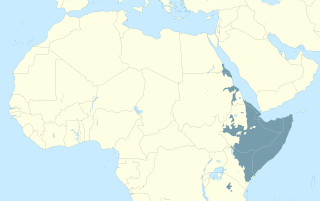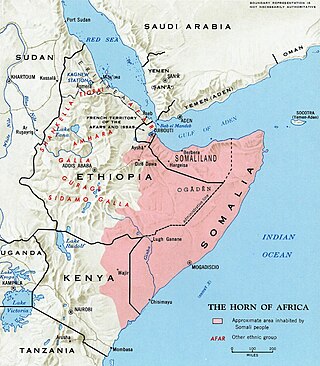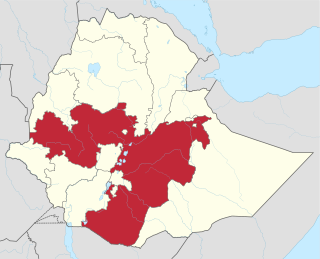Related Research Articles

The Cushitic languages are a branch of the Afroasiatic language family. They are spoken primarily in the Horn of Africa, with minorities speaking Cushitic languages to the north in Egypt and Sudan, and to the south in Kenya and Tanzania. As of 2012, the Cushitic languages with over one million speakers were Oromo, Somali, Beja, Afar, Hadiyya, Kambaata, and Sidama.
Afar is an Afroasiatic language belonging to the Cushitic branch. It is spoken by the Afar people inhabiting Djibouti, Eritrea and Ethiopia.

Somali is an Afroasiatic language belonging to the Cushitic branch. It is spoken primarily in Greater Somalia, and by the Somali diaspora as a mother tongue. Somali is an official language in both Somalia and Ethiopia, and serves as a national language in Djibouti, it is also a recognised minority language in Kenya. The Somali language is officially written with the Latin alphabet although the Arabic script and several Somali scripts like Osmanya, Kaddare and the Borama script are informally used.

Oromia is a regional state in Ethiopia and the homeland of the Oromo people. Under Article 49 of Ethiopian Constitution, the capital of Oromia is Addis Ababa, also called Finfinne. The provision of the article maintains special interest of Oromia by utilizing social services and natural resources of Addis Ababa.
Shabo is an endangered language and likely language isolate spoken by about 400 former hunter-gatherers in southwestern Ethiopia, in the eastern part of the South West Ethiopia Peoples' Region.
Lowland East Cushitic is a group of roughly two dozen diverse languages of the Cushitic branch of the Afro-Asiatic family. Its largest representatives are Oromo and Somali.
Konso is a Lowland East Cushitic language spoken in southwest Ethiopia. Native speakers of Konso number about 200,000. Konso is closely related to Dirasha, and serves as a "trade language"—or lingua franca—beyond the area of the Konso people. Blench (2006) considers purported dialects Gato and Turo to be separate languages.
Sidama or Sidaamu Afoo is an Afro-Asiatic language belonging to the Highland East Cushitic branch of the Cushitic family. It is spoken in parts of southern Ethiopia by the Sidama people, particularly in the densely populated Sidama National Regional State (SNRS). Sidaamu Afoo is the ethnic autonym for the language, while Sidaminya is its name in Amharic. It is not known to have any specific dialects. The word order is typically SOV. Sidaama has over 100,000 L2 speakers. The literacy rate for L1 speakers is 1%-5%, while for L2 speakers it is 20%. In terms of its writing, Sidaama used an Ethiopic script up until 1993, from which point forward it has used a Latin script.
Siltʼe is an Ethiopian Semitic language spoken in South Ethiopia. A member of the Afroasiatic family, its speakers are the Siltʼe, who mainly inhabit the Siltʼe Zone in the Southern Nations, Nationalities, and Peoples' Region. Speakers of the Wolane dialect mainly inhabit the Kokir Gedebano district of Gurage Zone, as well as the neighbouring Seden Sodo district of the Oromia Region. Some have also settled in urban areas in other parts of the country, especially Addis Ababa.

The languages of Ethiopia include the official languages of Ethiopia, its national and regional languages, and a large number of minority languages, as well as foreign languages.

Kambaata people also spelt as Kambata or Kembata are a Cushitic ethnic group that inhabits the Southern Nations, Nationalities, and Peoples' Region of Ethiopia. They speak the Kambaata language. It was a province of Ethiopia beginning in the early 15th century through to the mid-17th century; Ethiopian rule was once again established in the late 19th century under Emperor Menelik II. During this first period, Kambaata province was largely Christianized. The former province is contained within the contemporary Kembata Tembaro Zone of SNNPR.
Hadiyya is the language of the Hadiya people of Ethiopia. It is a Highland East Cushitic language of the Afroasiatic family. Most speakers live in the Hadiya Zone of the Southern Nations, Nationalities, and People's Region (SNNPR).
Highland East Cushitic or Burji-Sidamo is a branch of the Afroasiatic language family spoken in south-central Ethiopia. They are often grouped with Lowland East Cushitic, Dullay, and Yaaku as East Cushitic, but that group is not well defined. The most populous language is Sidama, with close to two million speakers.
Kambaata is a Highland East Cushitic language, part of the larger Afro-Asiatic family and spoken by the Kambaata people. Closely related varieties are Xambaaro, Alaba, and Qabeena (K'abeena), of which the latter two are sometimes divided as a separate Alaba language. The language has many verbal affixes. When these are affixed to verbal roots, there are a large amount of morphophonemic changes. The language has subject–object–verb order. The phonemes of Kambaata include five vowels, a set of ejectives, a retroflexed implosive, and glottal stop.
Baiso or Bayso is an Afro-Asiatic, more specifically a Lowland East Cushitic language belonging to the Omo-Tana subgroup, and is spoken in Ethiopia, in the region around Lake Abaya.

Ethiopia is a landlocked sovereign country located in the Horn of Africa. Ethiopia is bordered by Eritrea to the north, Sudan to the west, South Sudan to the south-west, Kenya to the south, Somalia to the east and Djibouti to the north-east. Ethiopia is one of the oldest countries in the world and Africa's second-most populous nation. Ethiopia has yielded some of humanity's oldest traces, making the area important in the history of human evolution. Recent studies claim that the vicinity of present-day Addis Ababa was the point from which human beings migrated around the world. Ethiopian dynastic history traditionally began with the reign of Emperor Menelik I in 1000 BC. The roots of the Ethiopian state are similarly deep, dating with unbroken continuity to at least the Aksumite Empire and its predecessor state, D`mt. After a period of decentralized power in the 18th and early 19th centuries known as the Zemene Mesafint, the country was reunited in 1855 by Kassa Hailu, who became Emperor Tewodros II, beginning Ethiopia's modern history. Ethiopia's borders underwent significant territorial expansion to its modern borders for the rest of the century, especially by Emperor Menelik II and Ras Gobena, culminating in its victory over the Italians at the Battle of Adwa in 1896 with the military leadership of Ras Makonnen, and ensuring its sovereignty and freedom from colonization. It was occupied by Benito Mussolini's Fascist Italy from 1936 to 1941, ending with its liberation by British Empire and Ethiopian Patriot forces. Its eastern border also changed in 1950 from the former 1908 Convention Line to the subsequent provisional administrative line.
The Somali languages form a group that are part of the Afro-Asiatic language family. They are spoken as a mother tongue by ethnic Somalis in Horn of Africa and the Somali diaspora. Even with linguistic differences, Somalis collectively view themselves as speaking dialects of a common language.

The Arbore are an ethnic group living in southern Ethiopia, near Lake Chew Bahir. The Arbore people are pastoralists. With a total population of 6,850, the Abore population is divided into four villages, named: Gandareb, Kulaama, Murale, and Eegude.
The Macro-Somali or Somaloid languages, or, Sam languages, are a branch of the Lowland East Cushitic languages. They are spoken in Somalia, Djibouti, eastern Ethiopia, and northern Kenya. The most widely-spoken member is Somali.

During World War I, Ethiopia briefly forged an alliance with the Allied Powers, following Italy's entry into the war in 1915. In June 1916, a dynastic conflict emerged when the uncrowned Emperor, Lij Iyasu, was alleged to have converted to Islam under the influence of the Ottoman Empire, which led him to be charged with apostasy. As a result, then-regent Ras Tafari Mekonnen, later known as Emperor Haile Selassie, orchestrated a coup d'état in September, deposing Lij Iyasu and installing Empress Zewditu on the throne. Throughout the war, Empress Zewditu maintained a stance of neutrality.
References
- ↑ Girirra at Ethnologue (25th ed., 2022)

- ↑ SILESR2002 061
- ↑ Blench, Roger (2006). "The Afro-Asiatic Languages Classification and Reference List" (PDF).
{{cite journal}}: Cite journal requires|journal=(help) - ↑ Mekonnen, Hundie Kumbi. 2015. The Grammar of Girirra (A Lowland East Cushitic Language of Ethiopia). (Doctoral dissertation, Addis Ababa University; xxvii+367pp.)